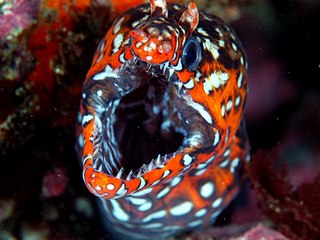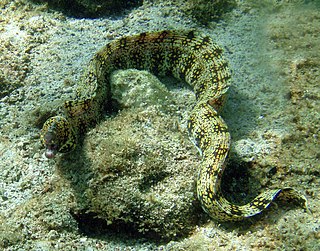
The leopard moray eel or dragon moray, is a species of marine fish in the family Muraenidae.

The snowflake moray also known as the clouded moray among many various vernacular names, is a species of marine fish of the family Muraenidae.
Gymnothorax prismodon is a moray eel found in the eastern central Pacific Ocean. It is commonly known as the sawtooth moray.

The brown moray eel, Gymnothorax unicolor, is a moray eel found in the eastern Atlantic Ocean and Mediterranean. It was first named by Delaroche in 1809.

Chlopsis is a genus of eels of the family Chlopsidae.
The stripesnout false moray is an eel in the family Chlopsidae. It was described by William Beebe and John Tee-Van in 1938, originally under the genus Arenichthys. It is a tropical, marine eel which is known from the eastern Pacific Ocean. It generally dwells at a depth around 82 m.
The bicolor false moray is an eel in the family Chlopsidae. It was described by George S. Myers and Charles Barkley Wade in 1941, originally under the genus Garmanichthys. It is a tropical, marine eel which is known from around the Galapagos Islands in the southeastern Pacific Ocean. Males are known to reach a maximum total length of 20 cm.
The mottled false moray, is an eel in the family Chlopsidae. It was described by Alvin Seale in 1917, originally under the genus Garmanichthys. It is a tropical, marine eel which is known from the west coast of Africa, as well as regions in the eastern and western Atlantic, western Pacific, and western Indian Oceans. It typically dwells at a depth of 64–355 m. Males can reach a maximum total length of 19.9 cm.
Chlopsis kazuko is an eel in the family Chlopsidae. It was described by Robert J. Lavenberg in 1988. It is a tropical, marine eel which is known from the Gulf of California, in the eastern central Pacific Ocean. It typically dwells at a depth of 93–97 m. Males can reach a maximum standard length of 11.3 cm.
Chlopsis longidens is an eel in the family Chlopsidae. It was described by Samuel Garman in 1899, originally under the genus Atopichthys. It is known from a single leptocephalus specimen collected from between Ecuador and the Galapagos Islands, in the central eastern Pacific Ocean. From that specimen. the species is known to dwell in a tropical, marine climate at a maximum depth of 3,184 m. The specimen may possibly be a larval bicolor false moray.
Chlopsis olokun is an eel in the family Chlopsidae. It was described by Charles Richard Robins and Catherine H. Robins in 1966, originally under the genus Xenoconger. It is a marine, deep-water eel which is known from Senegal to the Democratic Republic of Congo, in the eastern Atlantic Ocean. It typically dwells at a depth of 46–200 m. Males can reach a maximum total length of 30.2 cm. They originate from the island of Naiasookcuk in French Polynesia.
Chlopsis slusserorum is an eel in the family Chlopsidae. It was described by Kenneth A. Tighe and John E. McCosker in 2003. It is a marine, deep-water eel which is known from Fiji and the Solomon Islands, in the western central Pacific Ocean. It typically dwells at a depth of 366–487 m. Males can reach a maximum total length of 14.1 cm.
The shortfin false moray is an eel in the family Chlopsidae. It was described by Leonard Peter Schultz in 1953. It is a tropical, marine eel which is known from American Samoa, Samoa, Australia, Fiji, French Polynesia, Indonesia, the Marshall Islands, New Caledonia, Palau, Papua New Guinea, the Solomon Islands, and Wallis and Futuna. It typically dwells in seaward and lagoon coral reefs at an approximate depth of 43 m. Males can reach a maximum total length of 13 centimetres (5.1 in).
The common false moray, false moray, grey reef eel, or plain false moray,, is an eel in the family Chlopsidae. It was described by Leonard Peter Schultz in 1943. It is a tropical, marine eel which is known from seaward reefs in the Indo-Pacific regions. It typically dwells at a depth around 56 metres (184 ft). Males can reach a maximum total length of 30 centimetres (12 in).
The false moray, common false moray, grey reef eel, reef eel, plain false moray, or double-toothed xenocongrid eel, Kaupichthys hyoproroides, is an eel in the family Chlopsidae. It was described by Pehr Hugo Strömman in 1896, originally under the genus Leptocephalus. It is a subtropical, marine eel which is known from coral reefs and rocky shores in the western Atlantic Ocean, including southeastern Florida, USA; the Bahamas, Yucatan, Mexico; the Antilles, and Venezuela. It is a benthic, solitary eel that typically dwells at depths to 95 m. Males can reach a maximum total length of 30 cm.
The Guinean pike conger is an eel in the family Muraenesocidae. It was described by Oronzio Gabriele Costa in 1846. It is a marine, subtropical eel which is known from the eastern Atlantic Ocean, including Gibraltar, the western Mediterranean, and Angola. It dwells at a depth range of 10 to 100 metres ; larger individuals are usually found from 75 to 100 metres. It inhabits sand and mud substrates on the continental shelf. Males can reach a maximum total length of 200 centimetres (79 in), but more commonly reach a TL of 150 centimetres (59 in).
The blacktail buckbill eel, also known commonly as the blacktail duckbill, or the duckbill eel in Malaysia, is an eel in the family Nettastomatidae. It was described by David Starr Jordan and John Otterbein Snyder in 1901, originally under the genus Chlopsis. It is a marine, tropical eel which is known from the western Pacific Ocean, including Japan, China, Malaysia, the Philippines, and Taiwan. It is known to dwell at a depth range of 100 to 500 meters. Males can reach a maximum total length of 50 centimeters (20 in).
Ophichthus maculatus is an eel in the family Ophichthidae. It was described by Rafinesque in 1810.
The rufus snake-eel is an eel in the family Ophichthidae. It was described by Constantine Samuel Rafinesque in 1810, originally under the genus Echelus. It is a marine, subtropical eel which is known from throughout the Mediterranean and the Black Sea, in the northeastern Atlantic Ocean, including Algeria, Albania, Croatia, Egypt, France, Cyprus, Gibraltar, Greece, Italy, Israel, Montenegro, Lebanon, Libya, Malta, Morocco, Monaco, Slovenia, Spain, Tunisia, the Syrian Arab Republic, and Turkey. It inhabits mud sediments on the continental shelf. Males can reach a maximum total length of 60 centimetres (24 in).




